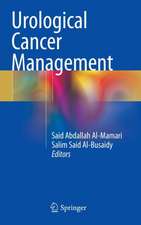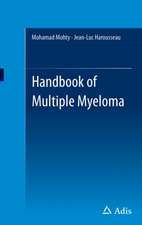Exercise and Cancer Survivorship: Impact on Health Outcomes and Quality of Life
Editat de John Saxton, Amanda Daleyen Limba Engleză Paperback – 5 sep 2014
The book is aimed at final year Undergraduate and Master's level students of Exercise Science, who are interested in working with clinical populations such as cancer patients. Many university Sport and Exercise Science courses in the UK and USA now have modules which are focused on exercise for health, and cover aspects of exercise science which are appropriate for clinical populations. The book would also be a very valuable resource for Undergraduate and Postgraduate Physiotherapy courses and a very useful resource for students of Exercise Science and Physiotherapy, as well as practitioners working with cancer patients.There are an increasing amount of research opportunities for exercise scientists who are interested in working with clinical populations. Furthermore, a considerable amount of Government and Charity research funding is being targeted at active lifestyles and this is helping to generate a new culture of collaboration between exercise scientists and medics. Hence, it is highly likely that an increasing number of students from Sport and Exercise Science courses will pursue careers within the clinical realm in the future. Practicing exercise therapists, clinical exercise physiologists and physiotherapists would also find lots of useful up-to-date knowledge to support their evidence-based clinical practice. This book would also be of interest to informed readers who are themselves undergoing or recovering from cancer treatment.
| Toate formatele și edițiile | Preț | Express |
|---|---|---|
| Paperback (1) | 1281.69 lei 6-8 săpt. | |
| Springer – 5 sep 2014 | 1281.69 lei 6-8 săpt. | |
| Hardback (1) | 1412.99 lei 6-8 săpt. | |
| Springer – 5 ian 2010 | 1412.99 lei 6-8 săpt. |
Preț: 1281.69 lei
Preț vechi: 1349.16 lei
-5% Nou
Puncte Express: 1923
Preț estimativ în valută:
245.26€ • 262.26$ • 204.49£
245.26€ • 262.26$ • 204.49£
Carte tipărită la comandă
Livrare economică 18 aprilie-02 mai
Preluare comenzi: 021 569.72.76
Specificații
ISBN-13: 9781489984944
ISBN-10: 1489984941
Pagini: 260
Ilustrații: XVI, 244 p.
Dimensiuni: 155 x 235 x 14 mm
Greutate: 0.37 kg
Ediția:2010
Editura: Springer
Colecția Springer
Locul publicării:New York, NY, United States
ISBN-10: 1489984941
Pagini: 260
Ilustrații: XVI, 244 p.
Dimensiuni: 155 x 235 x 14 mm
Greutate: 0.37 kg
Ediția:2010
Editura: Springer
Colecția Springer
Locul publicării:New York, NY, United States
Public țintă
Professional/practitionerDescriere
An increasing number of exercise scientists are applying their skills collaboratively (with medics and physiotherapists) to clinical populations and investigating the effects of exercise in relation to wide-ranging clinical, pathophysiological and psycho-social outcomes. This book would be a very useful resource for students of Exercise Science and Physiotherapy, as well as practitioners working with cancer patients.
The book is aimed at final year Undergraduate and Master's level students of Exercise Science, who are interested in working with clinical populations such as cancer patients. Many university Sport and Exercise Science courses in the UK and USA now have modules which are focused on exercise for health, and cover aspects of exercise science which are appropriate for clinical populations. The book would also be a very valuable resource for Undergraduate and Postgraduate Physiotherapy courses. There are an increasing amount of research opportunities for exercise scientists who are interested in working with clinical populations. Furthermore, a considerable amount of Government and Charity research funding is being targeted at active lifestyles and this is helping to generate a new culture of collaboration between exercise scientists and medics. Hence, it is highly likely that an increasing number of students from Sport and Exercise Science courses will pursue careers within the clinical realm in the future. Practicing exercise therapists, clinical exercise physiologists and physiotherapists would also find lots of useful up-to-date knowledge to support their evidence-based clinical practice. This book would also be of interest to informed readers who are themselves undergoing or recovering from cancer treatment. This means that the potential market in the UK, USA and other English-speaking nations is huge.
Here is a list of the books currently in use in these courses:
The book is aimed at final year Undergraduate and Master's level students of Exercise Science, who are interested in working with clinical populations such as cancer patients. Many university Sport and Exercise Science courses in the UK and USA now have modules which are focused on exercise for health, and cover aspects of exercise science which are appropriate for clinical populations. The book would also be a very valuable resource for Undergraduate and Postgraduate Physiotherapy courses. There are an increasing amount of research opportunities for exercise scientists who are interested in working with clinical populations. Furthermore, a considerable amount of Government and Charity research funding is being targeted at active lifestyles and this is helping to generate a new culture of collaboration between exercise scientists and medics. Hence, it is highly likely that an increasing number of students from Sport and Exercise Science courses will pursue careers within the clinical realm in the future. Practicing exercise therapists, clinical exercise physiologists and physiotherapists would also find lots of useful up-to-date knowledge to support their evidence-based clinical practice. This book would also be of interest to informed readers who are themselves undergoing or recovering from cancer treatment. This means that the potential market in the UK, USA and other English-speaking nations is huge.
Here is a list of the books currently in use in these courses:
- ACSM's Exercise Management for Persons With Chronic Diseases and Disabilities (American College of Sport Medicine).
- ACSM's Resources for Clinical Exercise Physiology (American College of Sport Medicine).
- Clinical Exercise Physiology, Edited by Ehrman JK, Gordon PM, Visich PS, Keteyian SJ. (Human Kinetics).
- Clinical Exercise Physiology: Applications and Physiological Principles, edited by LeMura LM, von Dullivard SP (Lippincott, Williams and Wilkins).
- Clinical Exercise Testing and Prescription, Edited by Roberts SO, Robergs RA, Hanson P (CRC Press, LLC).
Cuprins
CHAPTER 1: Introduction John Saxton and Amanda Daley 1.1 Abstract 1.2 The burden of cancer 1.3 Stages of the cancer experience 1.4 Exercise and the cancer survivor 1.4.1 Cancer as a ‘Teachable moment’ 1.4.2 Health benefits of exercise 1.4.3 Exercise terminology 1.4.4 Exercise guidelines for cancer survivors 1.5 Levels of evidence 1.5.1 General overview 1.5.2 Observational studies 1.5.3 Qualitative studies 1.5.4 Randomized controlled trials 1.6 Dose-response issues 1.7 Aims of this book 1.8 References CHAPTER 2: Exercise and cancer-related fatigue syndrome Margaret L McNeely and Kerry S Courneya 2.1 Abstract 2.2 Introduction 2.2.1 Incidence of CRF 2.2.2 Etiology of CRF 2.2.3 Conceptual framework for the study of CRF 2.3 Assessment of CRF 2.3.1 Clinical syndrome of CRF 2.3.2 CRF-specific measurement instruments 2.4 Management strategies for CRF 2.4.1 Pharmacological interventions 2.4.2 Psychosocial interventions 2.4.3 Exercise interventions 2.4.3.1 Breast cancer 2.4.3.2 Prostate cancer 2.4.3.3 Hematopoietic stem cell transplantation 2.4.3.4 Advanced cancer 2.4.4.5 Combined interventions for CRF 2.5 Special considerations for exercise testing and programming 2.5.1 Screening for exercise participation 2.5.2 Exercise testing 2.5.3 Exercise programming 2.5.3.1 Prescription considerations for patients with poor functional capacity 2.5.3.2 Intermittent or interval exercise training 2.5.3.3 Muscular fitness training 2.5.3.4 The training index 2.5.3.5 Pacing 2.6 Summary and conclusions 2.7 References CHAPTER 3: Exercise as an intervention during breastcancer treatment Martina Markes 3.1 Abstrac 3.2 Introduction 3.2.1 Impact of breast cancer treatment 3.2.2 Physical activity behaviours 3.3 The evidence base for exercise: a systematic review 3.3.1 Methods of the systematic review 3.3.2 Description of studies 3.3.3 Effects 3.3.3.1 Physical and mental health 3.3.3.2 Adverse effects 3.3.4 Exercise adherence and maintenance 3.3.5 Quality of the evidence 3.3.6 Applicability of the evidence to the breast cancer population 3.3.7 Implications for research 3.4 Implementation and dissemination 3.5 Summary 3.6 References CHAPTER 4: Exercise after treatment for breast cancer: effects on quality of life Helen Crank and Amanda Daley 4.1 Abstract 4.2 Introduction 4.2.1 Incidence and survival from breast cancer 4.2.2 Consequences of breast cancer 4.2.3 Psychosocial and psychosocial interventions 4.3 The potential role of exercise after treatment for breast cancer 4.4 Chapter overview 4.5 Is exercise an effective quality of life intervention after treatment for breast cancer? Summary of the evidence 4.5.1 Setting the scene: early intervention studies 4.5.2 The ’boom’ years 4.5.2.1 Trials of supervised aerobic exercise 4.5.2.2 Weight-training and resistance exercise interventions 4.5.2.3 Combined aerobic exercise and resistance training interventions 4.5.2.4 Pragmatic home-based exercise interventions 4.5.2.5 Alternative modes of exercise 4.5.2.6 Exercise versus other quality of life interventions 4.6 Reviews and meta-analyses 4.7 ‘What’s it like?’ Cancer survivor experiences of exercise 4.8 What next? 4.9 Summary and conclusions 4.10 References CHAPTER 5:
Textul de pe ultima copertă
An increasing number of people are now surviving for longer periods of time after a cancer diagnosis due to effective screening programs and treatments. In 2008, 25 million people were either living with cancer or recovering from cancer treatment worldwide. This means that the quality of cancer survival has become an important issue in the management of cancer patients.
The cancer experience is widely acknowledged as a life-changing event and can be the trigger for reviewing personal health behaviours and making major lifestyle changes. Evidence suggests that regular exercise participation during and after cancer treatment is associated with higher levels of physical functioning, reduced feelings of fatigue and improved health-related quality of life. Studies have also shown that a physically active lifestyle can protect against cancer mortality.
Exercise and Cancer Survivorship: Impact on Health Outcomes and Quality of Life explores the impact of a physically active lifestyle on health outcomes that are highly relevant to cancer patients at all stages of the cancer experience. Twelve active and eminent researchers or research groups in this field from the USA, Canada and Europe present an up-to-date synthesis of the scientific evidence. We hope that the book will provide an impetus for further research in the field, so that ultimately, all cancer patients will have the opportunity to experience the benefits that exercise might have to offer to them.
The cancer experience is widely acknowledged as a life-changing event and can be the trigger for reviewing personal health behaviours and making major lifestyle changes. Evidence suggests that regular exercise participation during and after cancer treatment is associated with higher levels of physical functioning, reduced feelings of fatigue and improved health-related quality of life. Studies have also shown that a physically active lifestyle can protect against cancer mortality.
Exercise and Cancer Survivorship: Impact on Health Outcomes and Quality of Life explores the impact of a physically active lifestyle on health outcomes that are highly relevant to cancer patients at all stages of the cancer experience. Twelve active and eminent researchers or research groups in this field from the USA, Canada and Europe present an up-to-date synthesis of the scientific evidence. We hope that the book will provide an impetus for further research in the field, so that ultimately, all cancer patients will have the opportunity to experience the benefits that exercise might have to offer to them.
Caracteristici
There is no book currently on the market that collates all the most up-to-date scientific literature on exercise after a cancer diagnosis in one volume, and in relation to outcomes that are meaningful to the patients
Includes supplementary material: sn.pub/extras
Includes supplementary material: sn.pub/extras









